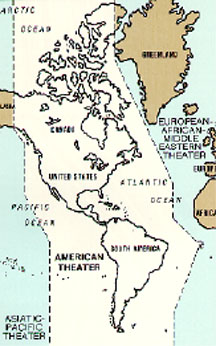|
History Notes Chapter 3, Page 2 of 7 Pages World War II: Uncharted Territory |
||||||||||||||||||||
|
Here we see an F-10 crew dressed for serious work over remote areas. Note the 91st SRS Emblem displayed on the side of the aircraft and the nose camera ports on both lower sides of the aircraft. This photo provided by Lt. “Jake” Jacobson |
||||||||||||||||||||
 |
||||||||||||||||||||
| U.S. civilian and military leaders were concerned with Nazi Germany’s preoccupation with South and Central America. In order to prepare for possible hostilities in our own backyard, the military planners needed accurate charts and maps of all of these regions. Millions of square miles were virtually unexplored and uncharted. The 91st was given the tremendous task of getting this job done through aerial photography. |
||||||||||||||||||||
| Between April 1943 and June 1945, the 91st flew throughout South and Central America and the Caribbean. Staging from Ramey Field, Puerto Rico, aircraft and crews were sent on “TDYs” all over the northern portions of South American continent and Central America. The unit underwent five redesignations from the 91st Reconnaissance Squadron (Bomber) through 91st Photographic Mapping and Charting Squadron to the 91st Reconnaissance (Long Range, Photo). This evolution took place as the 91st received and flew a number of different airframes--predominately the B-25 “Mitchell” bomber and the B-17 “Flying Fortress” bomber. |
||||||||||||||||||||
 |
||||||||||||||||||||
|
|
||||||||||||||||||||
 |
||||||||||||||||||||
|
|
||||||||||||||||||||
 |
||||||||||||||||||||
|
Three views of the photo reconnaissance version of the B-17B, identified as the F-9 |
||||||||||||||||||||
 |
||||||||||||||||||||
 |
||||||||||||||||||||
|
For its committed service in preparing civilian and military leaders and planners for a possible spread of the worldwide conflict in our own hemisphere, the 91st was awarded the American Defense Campaign Streamer and its personnel were authorized to wear the American Defense Campaign Medal and Ribbon.
|
||||||||||||||||||||
 |
||||||||||||||||||||
 |
||||||||||||||||||||
|
|
||||||||||||||||||||
 |
||||||||||||||||||||
|
EDITOR’S NOTE: The next five pages include a selection of related photographs, some with full identification and some that are not specifically or only partially identified. These photos all relate to the aircraft and crews that served with the 91st Squadron during this period. Dependent upon your level of interest, you may move on to the remaining pages of this chapter or you may go directly on to Chapter 4. |
||||||||||||||||||||
|
End of Page 2 of 7 Pages, Chapter 3 — Go to Page 3 or you may go to Chapter 4 Chapters — 1 — 2 — 3 — 4 — 5 — 6 — 7 |
||||||||||||||||||||